
Boronia pinnata is a plant in the citrus family, Rutaceae, and is endemic to New South Wales. It is an erect, woody shrub with pinnate leaves and groups of between three and forty pink flowers arranged in leaf axils. It flowers in spring and early summer and is found in coastal areas between Ballina and Jervis Bay.

Boronia muelleri, commonly known as the forest boronia or pink boronia, is a flowering plant that occurs in forest, woodland and heath in Victoria and New South Wales in Australia. It is an erect, woody shrub or small tree with pinnate leaves and up to fifteen pink to white four-petalled flowers arranged in leaf axils in spring and summer.

Boronia safrolifera, commonly known as safrole boronia, is a species of flowering plant that is endemic to eastern Australia. It is an erect, woody shrub with pinnate leaves that have up to nineteen leaflets, and white to pink, four-petalled flowers.

Cyanothamnus anemonifolius, commonly known as narrow-leaved boronia or sticky boronia, is a flowering plant that is endemic to south-eastern Australia. It is a shrub with mostly pinnate leaves, with white to pale pink four-petalled flowers in leaf axils.
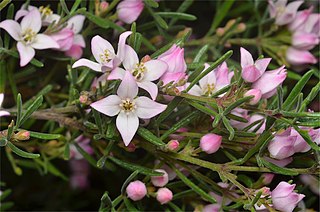
Boronia hippopalus, commonly known as velvet boronia is a plant in the citrus family Rutaceae and is endemic to Tasmania. It is an erect, woody shrub with pinnate leaves and white to pink, four-petalled flowers.
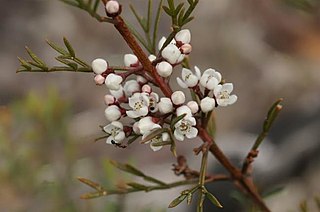
Cyanothamnus occidentalis, commonly known as the rock boronia, is a plant in the citrus family Rutaceae and is endemic to eastern Australia. It is an erect, woody shrub with pinnate or bipinnate leaves and groups of up to three white to pale pink, pink four-petalled flowers arranged in leaf axils.

Boronia pilosa, commonly known as the hairy boronia, is a plant in the citrus family Rutaceae and is endemic to south-eastern Australia. It is an erect, woody shrub with hairy branches, pinnate, sometimes hairy leaves and groups of up to ten white to pink, four petalled flowers.

Cyanothamnus rigenss, commonly known as the stiff boronia, is a plant in the citrus family Rutaceae and is endemic to south-eastern New South Wales in Australia. It is a low, compact shrub with mostly trifoliate, glandular leaves and white to pale pink, four-petalled flowers in the leaf axils.

Boronia rivularis, commonly known as the Wide Bay boronia, is a plant in the citrus family Rutaceae and is endemic to the Wide Bay–Burnett area of eastern Queensland. It is an erect, woody shrub with pinnate leaves and white to pink, four-petalled flowers.
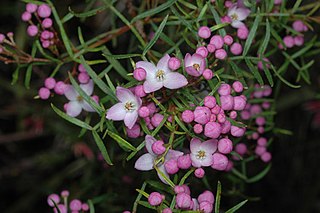
Boronia thujona, commonly known as the bronzy boronia, is a plant in the citrus family Rutaceae and is endemic to near coastal areas of southern New South Wales. It is a shrub or small tree with aromatic, pinnate leaves and groups of between two and six bright pink flowers in the leaf axils.
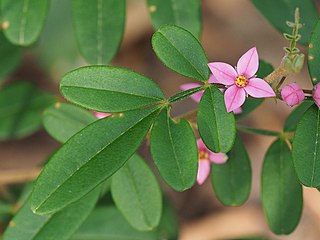
Boronia umbellata, commonly known as the Orara boronia, is a plant in the citrus family Rutaceae and is endemic to a small area on the north coast of New South Wales. It is an erect shrub with many branches, aromatic, pinnate leaves and clusters of up to ten dark pink flowers in the leaf axils.

Boronia warrumbunglensis is a plant in the citrus family Rutaceae and is endemic to a small area in the central west of New South Wales. It is a shrub with many branches, pinnate leaves and one or two pink, four-petalled flowers in the leaf axils. It is only known from the Warrumbungles and nearby districts.
Boronia citrata, commonly known as lemon boronia, is a plant in the citrus family, Rutaceae and is endemic to Victoria. It is an erect, woody shrub with pinnate, strongly lemon-scented leaves and pale pink to rosy pink, four-petalled flowers arranged in groups of up to five.

Boronia elisabethiae is a plant in the citrus family Rutaceae and is endemic to Tasmania. It is a semi-erect or weakly spreading, woody shrub with pinnate leaves and white to pink, four-petalled flowers.

Boronia galbraithiae, commonly known as the aniseed boronia or Galbraith's boronia, is a plant in the citrus family Rutaceae and is endemic to a small area in Victoria. It is an erect, woody, fennel-scented, hairless shrub with pinnate leaves and white to deep pink, four-petalled flowers arranged in groups in the leaf axils.
Boronia hoipolloi is a plant in the citrus family Rutaceae and is endemic to a small area in Queensland. It is an erect or pendulous shrub with pinnate leaves and pink, four-petalled flowers. It is only known from a few collections near Mount Isa.
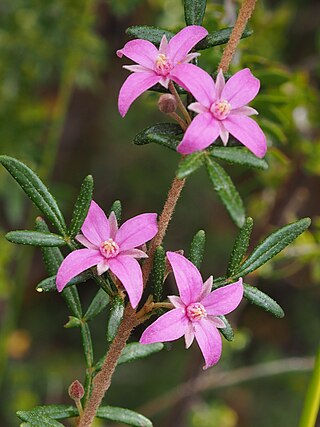
Cyanothamnus inflexus is a plant in the citrus family Rutaceae and is endemic to tablelands near the New South Wales - Queensland border in Australia. It is an erect, woody shrub with pinnate leaves and up to seven white to pink four-petalled flowers in the leaf axils. Boronia bipinnata is similar but has larger, bipinnate or tripinnate leaves and smaller sepals and petals.
Cyanothamnus montimulliganensis is a plant in the citrus family Rutaceae and is endemic to a single mountain in Queensland. It is an erect, woody shrub with pinnate or bipinnate leaves and white, four-petalled flowers usually arranged singly in leaf axils.

Boronia ruppii, commonly known as Rupp's boronia, is a species of plant in the citrus family Rutaceae and is endemic to a small area in New South Wales. It is a shrub with hairy branches, simple and trifoliate leaves and pink, four-petalled flowers in the leaf axils. It only grows around the abandoned Woodsreef asbestos mine.
Cyanothamnus yarrowmerensis is a species of erect, woody shrub that is endemic to Queensland. It has pinnate or bipinnate leaves and groups of up to seven flowers with white petals in leaf axils.

















